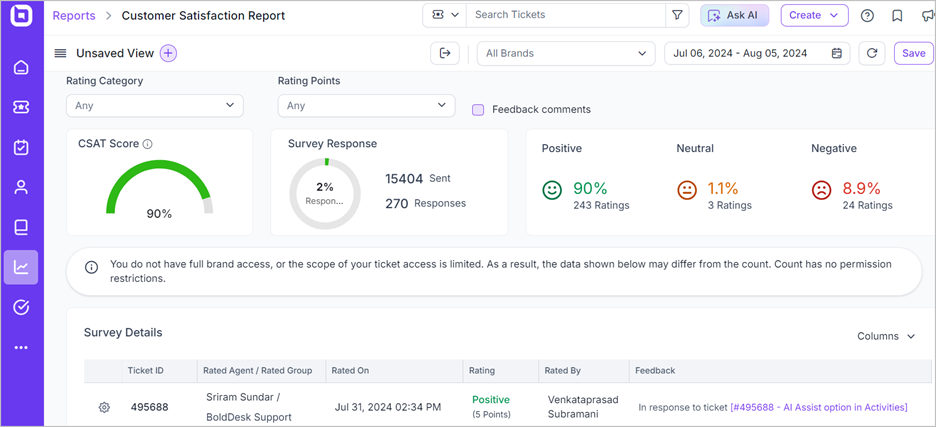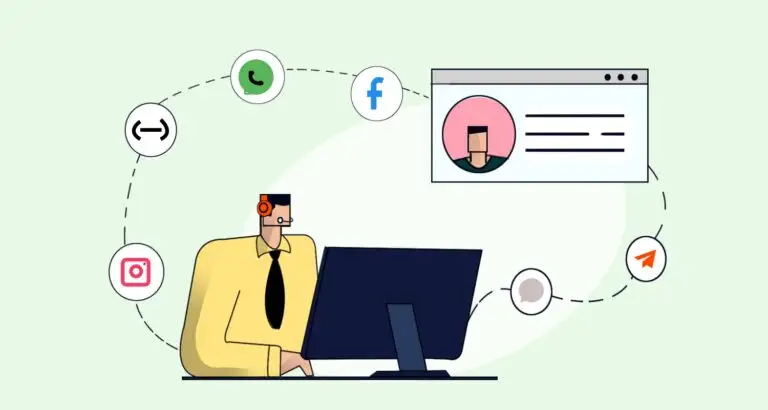Customers expect a successful sales experience and excellent support before and after the sale. While sales teams concentrate primarily on acquiring new customers, customer service teams ensure these customers remain satisfied.
This shows how both sales and customer service are key factors that are increasing the success of modern companies.
Although each team has its own goals, purposes, and approaches, the big question is: How can the sales and customer service employees work together for the common good of the customer and overall business success?
This article clearly explains the differences, the similarities, and how two teams can work together effectively to achieve wonderful goals.
Below are the differences between sales and customer service
Sales refers to selling goods or services to clients. Usually, the goal of sales teams is to close transactions, meet the targets, and increase the sales of the company.
On the other hand, customer service means the assistance a customer receives even before, during, and after a purchase.
It usually involves solving consumer issues, answering their question, and further with them to build up good relationships and confirm customer satisfaction.
However, there are essential differences that set them apart:
| Characteristics | Sales | Customer service |
| Focus | Concentrate on closing deals and generating revenue | Focuses on offering support and resolving issues for new and existing customers |
| Communication | Consistently use persuasive language and tactics to sell products or services | Use supportive and empathetic communication to address customers’ needs and concerns |
| Aims | Are always pushed by sales objectives and targets | Guarantee customer happiness and customer retention rates |
| Approach | Think before the issue occurs and try to reach out to frequent customers’ problems | They are reactive in responding to customers’ inquiries and complaints |
| Relationship | Build new relationships with customers | Maintain and build long-term relationships with new and existing customers |
| Training | Are often trained in sales techniques and negotiation skills | Are trained in problem-solving and conflict resolution |
Similarities between customer service vs sales representatives
The sales teams and support agents have a lot in common in terms of their goals, the list is endless. Let’s look at some:

Commitment to ensuring client satisfaction: Sales reps try to connect end users to the best solutions while support agents ensure that consumers are always satisfied after purchasing. Each team offers satisfying experiences and gives clients a sense of support and value.
Maintain customer relationships: Both teams should aim to create a good rapport with their clients in order to win their loyalty, whether they are resolving an issue or closing a sale.
Practical communication skills: Good communication is vital for both sales and support teams. Whether trying to convince a potential consumer to buy a product or just understanding their concerns, both teams must be able to listen effectively and communicate clearly. Adjusting their communication style will meet the needs of your customer base.
Problem-solving abilities: Customer happiness means both teams quickly and correctly address their issues. While customer service teams excel at resolving customer problems, sales representatives are skilled at addressing objections to meet customer needs.

Product or service knowledge: Both roles are essential to understanding business products or services.
Team collaboration: Customer and sales teams can work with all the departments to provide a better customer service experience.
Some of these teams they can collaborate with include:
- Marketing department
- Product development
- Technical support
Both teams prioritize business success: Both departments understand that happy customers are valuable assets for the company’s financial success.
Salespeople are attracting more and new customers into the businesses and then close transactions, which makes it beneficial to the business.
Customer service indirectly influences revenue by increasing customer happiness and retention, encouraging repeat business and favorable word-of-mouth.
7 Ways sales and customer service team can collaborate
Sales and customer service shouldn’t work in silos. When these two teams work together in an organization, it allows a seamless experience for customers.
Here are some of the ways they can collaborate effectively:
Share customer data
Sharing customer data and insights across customer service and sales divisions benefits both departments.
To enable sales teams to handle these difficulties proactively during their encounters, customer support teams might provide feedback on frequent problems or client complaints.
Sales and customer service teams may access and update customer information in real time, track customer interactions, and align all customer-facing activities using a shared contact management (CRM) system.
They can also both use metrics such as customer satisfaction, sales data (LTV and average revenue), average response time, and customer retention to get valuable insights.
In fact, a report from Salesforce shows that 82% of sales representatives report that they understand which metrics determine their compensation.
By understanding all these metrics, salespeople can better tailor their approach to customers, while customer service teams can focus on improving their response times and overall customer experience.
Answers problems as a group
When faced with complex customer issues, sales and customer service teams can collaborate to find innovative solutions that meet the customers’ needs and company goals.
Both the sales and customer service teams want to see the business succeed. By working together effectively, they are more likely to accelerate growth.
Both teams can utilize the MS Teams for customer service for real-time chat, voice, and video communication to seek information when faced with difficulties.
Additionally, it would help if you implemented a knowledge base software for self-service options so that sales or customer service teams can easily access information and have it at their fingertips.
Accessing MS Teams will enable them to troubleshoot issues, answer questions correctly, and suggest appropriate solutions to consumers.
Create feedback loop
The sales teams can provide customer service representatives with valuable insights into what customers prefer and their pain points.
During the pre-purchase phase, both teams communicate with customers. They can negotiate with potential customers and understand their needs while closing deals.
After the transaction processes, they then share this data with customer service teams for post-purchase.

With real insights, the customer service team can step in and keep the commitments. Measuring customer satisfaction helps reduce the risk of turnover and promotes customer loyalty.
A strong customer feedback loop can help both agents to learn from each other and always develop their processes.
Upsell and cross-sell chances
If there’s an upsell opportunity on an account, customer service teams can provide sales team members with the customer’s communication history and satisfaction score.
The contact management feature can help both teams store and organize contacts and contact groups for their clients, enabling them to monitor all customer interactions with the brand and follow up accordingly.
Sales teams may use this information to understand customers better and recommend relevant products or services to their friends or families.
Collaborate on retention strategies
Since both teams aim to retain the existing customers, they have to work together. If either the sales or the support team finds any strategies that can keep the clients and avoid churn, they should share.
Features such as shared inbox software and Microsoft Teams enable smooth collaboration among team members.
Cross-team training
Cross-training can benefit sales and customer service teams by allowing them to understand each other’s roles, work together more effectively, and improve communication.
During onboarding processes, introduce both teams to the company policies, tools, and customers and provide the necessary knowledge to improve team productivity.
Businesses can this achieved by:
- Providing training programs that cover essential sales and customer service skills, including product knowledge, problem-solving, communication techniques, and objection handling.
- Organizing workshops where team members can share best practices, learn from each other, and develop a shared understanding of the customer experience.
- Offering online courses to provide flexible learning opportunities and easy access to many resources.
- Creating user manuals that clearly outline the steps involved in performing specific tasks, such as processing orders, handling customer inquiries, or resolving complaints.
- Prepare how-to videos that visually demonstrate illustrated procedures, making it easier for support teams to learn and retain information.
Besides, a lack of knowledge of sales or customer service agents can slow down and affect their ability to resolve customers’ issues quickly within the provided time.
The Comm100 report shows that 71% of customers (aged 16 to 24) think receiving a quick response from a support team may significantly enhance their overall experience.
By cross-training, teams can develop effective customer journey maps, allowing them to understand and anticipate potential problems and provide more efficient solutions.
Recognize and give rewards
Motivate sales and customer service teams to work together more effectively, by creating recognition and rewards programs that acknowledge their joint efforts.
Celebrating both customer service or sales teams’ collaboration achievements can help build their teamwork and drive better performance.
Foster collaboration between sales and customer service teams
Sales and customer service are like two sides of the rolling dice, each essential to a business’s success.
Since sales attract and close deals, customer service convinces them to stay by providing support and maintaining solid relationships.
Businesses can create a winning formula by taking a customer-centricity approach, understanding their differences, and encouraging collaboration between the customer service and the sales teams.
Contact us to book a live demo and discover the latest functionalities, allowing you to see how BoldDesk can enable collaboration between sales and customer service teams. You can also join for a 15-day free trial.
If you have any questions regarding sales vs customer service, please provide your ideas and suggestions in the section below.
Related articles


















 Email Ticketing System
Email Ticketing System Shared Inbox Software
Shared Inbox Software Multi Brand Help Desk
Multi Brand Help Desk Internal Help Desk Software
Internal Help Desk Software Trouble Ticketing Software
Trouble Ticketing Software Mobile Help Desk
Mobile Help Desk 


















